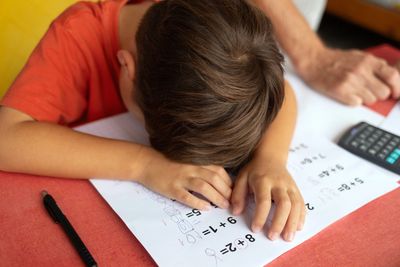DYSCALCULIA

Supporting Students with Dyscalculia
Dyscalculia, often referred to as "math dyslexia," is a learning difficulty that affects a student's ability to understand and work with numbers and mathematical concepts. Students with dyscalculia may struggle with basic arithmetic, recognizing patterns, or spatial reasoning. However, with appropriate support and accommodations, they can succeed in the classroom.
When considering how to best support a student with dyscalculia, consider the following:
What level of individualized support will this child need?
- Collaborate with parents, teachers, and specialists to develop an Individualized Education Plan (IEP) or 504 Plan if needed. This plan should include specific accommodations, such as additional time for math tasks or access to tools like calculators and visual aids.
- Use assessment data to identify specific areas of difficulty and tailor interventions to address these challenges.
What specific challenges does the student face with math concepts?
Understanding Numbers and Quantities:
- Students may have difficulty recognizing numbers, counting, or understanding quantity relationships.
- Use manipulatives (e.g., blocks, beads) to make abstract concepts concrete and relatable.
Performing Basic Arithmetic:
- Struggles may include adding, subtracting, multiplying, or dividing accurately and efficiently.
- Allow the use of fact charts or calculators and incorporate games that reinforce basic math skills in a non-threatening way.
Understanding and Applying Mathematical Concepts:
- Students may find it hard to grasp more abstract ideas, like fractions, decimals, or algebra.
- Break down complex problems into smaller steps, and use visuals or real-world examples to contextualize concepts.
How will you adapt classroom instruction?
- Multi-Sensory Approaches: Incorporate visual, auditory, and kinesthetic learning methods to reinforce math concepts. For example, use hands-on activities or rhythm and songs to teach multiplication tables.
- Chunking and Scaffolding: Break lessons into smaller, manageable parts, and build on skills incrementally.
- Technology Tools: Leverage apps and software designed for math learning, such as DreamBox, Mathletics, or Khan Academy.
How will assessments be adjusted for this student?
- Offer alternative assessment formats, such as oral explanations or project-based evaluations, to demonstrate understanding without the pressure of timed tests.
- Allow extended time on assessments and provide tools like calculators or step-by-step guides to reduce anxiety and frustration.
How can classroom materials and tools support the student?
- Use graph paper or lined paper to help with alignment during calculations.
- Provide visual aids, such as number lines, charts, and diagrams, to support conceptual understanding.
- Offer tools like counters, abacuses, or interactive digital resources to make learning more engaging.
What strategies can help with day-to-day math-related activities?
- Create a structured and predictable math routine to build confidence.
- Use repetition and reinforcement to help solidify foundational skills.
- Encourage collaborative learning through group activities or peer mentorship programs.
Are parents and teachers prepared for frequent and open communication?
- Regularly update parents on their child’s progress, including specific strategies that are working in the classroom.
- Share resources and activities that parents can use at home to reinforce skills and build confidence.
How can faith and values support the student?
- Emphasize the importance of perseverance, patience, and individual strengths, aligning with Catholic values.
- Encourage the student to see their unique challenges as opportunities for growth and resilience.
Are staff equipped with training on dyscalculia?
- Provide professional development on recognizing dyscalculia and implementing effective teaching strategies.
- Share resources on multi-sensory math instruction and accommodations for learning disabilities.
Accommodations and Resources
Instructional Accommodations:
- Provide visual aids, such as number lines, charts, and counters.
- Use graph paper to assist with organizing math problems.
- Allow use of calculators for basic computations.
- Provide step-by-step problem-solving guides and math fact reference sheets.
- Break down multi-step problems and use color coding to differentiate steps.
- Allow the use of math manipulatives, such as base-ten blocks or fraction tiles.
- Use multi-sensory math programs (e.g., TouchMath, Math-U-See).
Assessment Accommodations:
- Allow extended time for math assessments.
- Provide oral explanations of word problems.
- Use alternative assessment formats, such as projects or visual demonstrations.
- Allow for calculator use and provide access to reference charts.
Materials with Links:
- TouchMath Program
- XtraMath (math fluency practice)
- Khan Academy (online math tutorials and practice)
Trainings
1. Learning Disabilities Association of America (LDA)
- Offers webinars and resources for educators on supporting students with dyscalculia. - https://www.ldaamerica.org
2. Dyscalculia Training by the British Dyslexia Association
- Provides courses and resources for understanding and addressing dyscalculia.
- https://www.bdadyslexia.org.uk
3. Understood.org
- Free resources and articles on strategies for helping students with math difficulties.
Books and Articles
1. "The Dyscalculia Toolkit" by Ronit Bird
- Offers practical strategies and activities for teaching math to students with dyscalculia.
2. "Overcoming Dyscalculia and Difficulties with Numbers" by Ronit Bird
- Explains how to support students with dyscalculia using multi-sensory techniques.
3. "Math for Dyscalculia: A Teaching Handbook" by Steve Chinn
- Focuses on identifying and addressing specific math difficulties in the classroom.
4. "Making Math Real: A Roadmap to Understanding" by David Berg
- Offers insights into math instruction for students with learning differences.
5. "Teaching Mathematics to Students with Learning Disabilities" by Nancy S. Bley and Carol A. Thornton
- A comprehensive resource for teachers on adapting math instruction to meet diverse needs.
This website uses cookies.
We use cookies to analyze website traffic and optimize your website experience. By accepting our use of cookies, your data will be aggregated with all other user data.